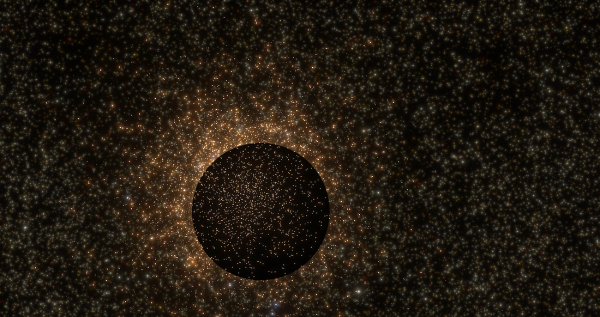BY LETTER
Daidarabotchi Megadyson, The
Sophonts > Xenosophonts > Alien Civilisations Outside the Terragen Sphere
Technology > Application > Megascale Engineering
Sophonts > Xenosophonts
Technology > Application > Megascale Engineering
Sophonts > Xenosophonts
The Daidarabotchi Megadyson, also known as the Ginnungagap Dyson, Starlight-Dies-In-Heaven, or Canes Venatici Hyperobject 1 among other names depending on the culture, is a dyson shell constructed by an unknown xenosophont civilization at least 6.32 Gyr ago located 14.166 Gly away (comoving distance). It is by far the largest dyson shell or contiguous megastructure of any kind known to Terragen civilization at 282.6 lightyears in diameter. While its mass is unknown it has been constrained between an upper bound of 28230 solar masses (based on gravitational deflection of nearby bodies) and a lower bound of 27.1 solar masses (based on probable construction materials and calculated minimum thickness of the shell) both with 99.5% confidence with a 60% probability of being within a factor of two of 4518 solar masses.
While the most favored theory regarding its origin and purpose is that it is the result of an out of control von Neumann swarm other hypotheses include,
- To act as an extremely large telescope similar to individual nodes of the Argus Array.
- To act as an enormous whipple shield protecting the interior from relativistic attack.
- As a shroud to hide whatever is happening inside from other civilizations.
- To protect the universe from perceiving an unknown virulent/contagious memetic, cognitive, or motivational hazard contained within.
- Reasons that are not understandable by modosophonts.
- The result of artistic/cultural/religious/miscellaneous irrationality on the part of its creators.
Due to its low temperature high resolution study of the Megadyson has relied in large part on ambient starlight and light echo of occasional supernovae. The surface of the Megadyson appears to be smooth with any irregularities being smaller than ~6cm, the resolution limit of the Argus Array at this distance when operating in extreme ultraviolet.
The Megadyson is surrounded by approximately ~20000 solar masses of visible matter, believed to be the remnants of a local star cluster that was not completely consumed during the Megadyson's construction. Extrapolating the cluster's density implies the existence of ~5000 solar masses of baryonic matter within the Megadyson.
The Daidarabotchi Megadyson is located approximately 200000 ly away from the nearest galaxy, a barred spiral galaxy that may be in the beginning stages of being converted into an artificially optimised galaxy of the red globular galaxy subtype.
The Megadyson appears to be occasionally pierced by intergalactic debris such as asteroids, planets, and stars. These holes appear to be quiescent at first but within 200-1200 days begin self-repairing at a rate of 17.2 m/s or approximately ~200 days per lightsecond. While the Argus Array is able to look through these holes while they exist no discernible objects can be viewed within suggesting that either the Megadyson is mostly empty and the array is viewing the far side of the shell or that some other measure prevents the observation of its interior.
Thus far 3 stellar systems and 4 stars have been observed to pierce the Megadyson's surface. The first, a red dwarf entering the Megadyson was observed by an ahuman AI telescope array around the white dwarf 0xD3425A0159+log(√τ) in 4091 AT, which was later released to the wider galaxy through data sharing agreements. Unfortunately the Argus Array did not observe this event as the lightfront had passed by its location over 60 years before it would be constructed. The second, the much anticipated passage of a K and M class binary system into the Megadyson observed in 6277 AT provided much data into its composition and significantly constrained its possible histories although much of the underlying analysis requires S:1 level or above logic to understand. Finally in 9984 AT the Outer Volume observation post Meryy Secundus observed a localized temperature increase on the surface of Megadyson followed by the area being torn apart by gravitational stresses and vaporized as an F2V star exited the Megadyson. It is currently expected that the lightcone of this event will begin to intersect the Argus Array in the early 13000s.
Related Articles
Appears in Topics
Development Notes
Text by NexusEye
Initially published on 14 June 2021.
Initially published on 14 June 2021.







